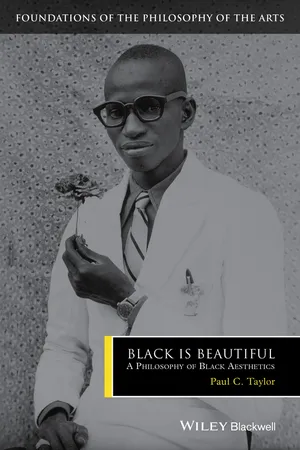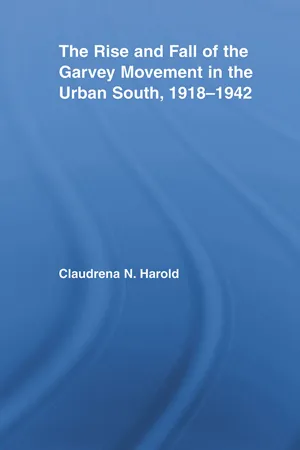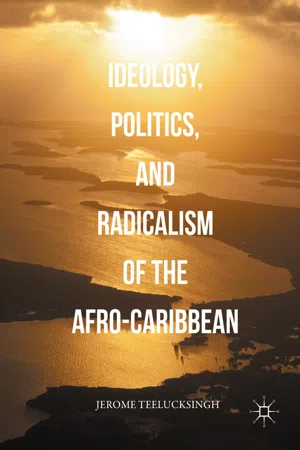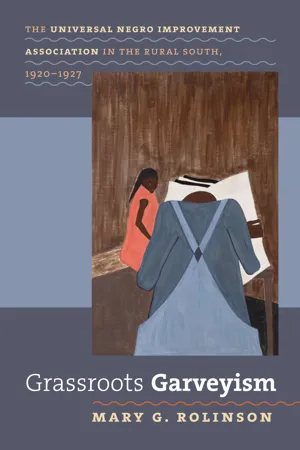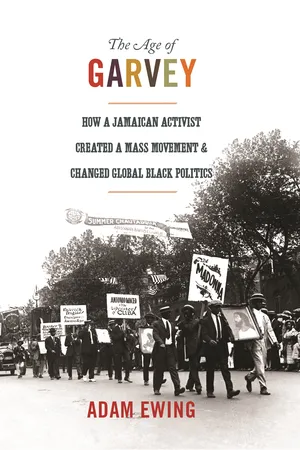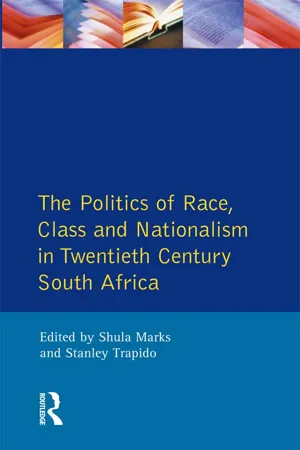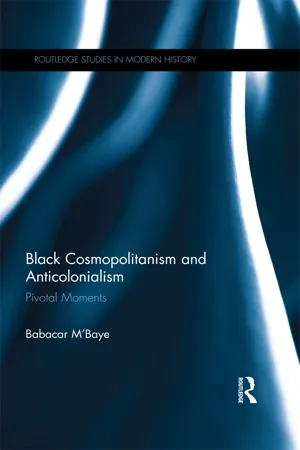Politics & International Relations
Marcus Garvey
Marcus Garvey was a Jamaican political leader and activist who founded the Universal Negro Improvement Association (UNIA) in the early 20th century. He advocated for the economic and political empowerment of black people worldwide and promoted the concept of Pan-Africanism. Garvey's ideas and efforts had a significant impact on the civil rights movement and the struggle for racial equality.
Written by Perlego with AI-assistance
Related key terms
Related key terms
1 of 4
Related key terms
1 of 3
9 Key excerpts on "Marcus Garvey"
- eBook - ePub
Black is Beautiful
A Philosophy of Black Aesthetics
- Paul C. Taylor(Author)
- 2016(Publication Date)
- Wiley-Blackwell(Publisher)
Some of the most familiar moments in this history emerge from enterprises that are allied with, analogous to, or implicated by the political. Of the many examples that we might choose to exemplify these moments, I propose to focus on the single case of Marcus Garvey, which has the virtue of clearly showing the three modes of relation at work in black politics all at once. 16 Marcus Garvey is rightly regarded as a canonical figure in the history of black politics. Like the other figures considered here, though, his importance transcends racial considerations. He belongs to the broader history of late modern culture and politics in ways that cannot be responsibly ignored. His dealings with the Ku Klux Klan, his impact on global anti-imperialist activism (beginning with his perhaps apocryphal encounter with Ho Chi Minh), and his mastery of modern political technique – mastery enough to mobilize “the largest … [and] broadest mass movement in Afro-American history” 17 – are, or ought to be, part of the story of twentieth-century politics, race notwithstanding. That said, Garvey’s claim on our attention begins with his pioneering roles in the histories of black nationalism and Pan-Africanism. As the founder of the Universal Negro Improvement Association (UNIA) and its journal, Negro World, he was an inescapable presence in the ferment of new world African political modernism. And as a symbol of the emancipatory aspirations of black freedom fighters, he remains an unavoidable cultural presence, featured prominently in world-spanning matrices of cultural expression like Rastafarianism, reggae music, and North American and African hip-hop. One of the more interesting features of Garvey’s political work, and one of the keys to his success, was his insistence on manipulating the aesthetic markers of national self-determination. The UNIA was known as much for its pageants and parades as for Garvey’s scintillating public speaking and the incendiary articles of Negro World - Claudrena N. Harold(Author)
- 2014(Publication Date)
- Routledge(Publisher)
3Claiming nearly five hundred UNIA divisions and branches by the mid-1920s, the Jim Crow South distinguished itself as a major stronghold of the Garvey movement. No small factor in the UNIA’s success was the charismatic personality of Marcus Garvey. Fiercely independent, the Jamaican-born nationalist appealed not only to black women and men who had spent all of their lives under the oppressive system of Southern Jim Crowism, but also to many West Indians who settled in the South during the first two decades of the twentieth century. Moved by Garvey’s Pan-African message of black pride, race unity, and economic independence, these black immigrants recognized the extent to which his personal triumphs, political struggles, and internationalist perspective corresponded with their own. Moreover, they embraced a man whose life had also been tremendously impacted by racism, economic dislocations and transformations in the Caribbean, and British imperialism.4The Political Rise of Marcus Mosiah GarveyThree years after the Berlin Conference officially sanctioned Europe’s ruthless partition of Africa, Sarah Richards gave birth to Marcus Garvey on August 17, 1887, in the seaport town of St. Ann’s Bay, Jamaica.5 Legalizing her union with Garvey’s father two years after her son’s birth, Sarah married Malchus Mosiah Garvey on December 15, 1889. Details on Marcus’ early life are rather hazy and at times contradictory, but by most accounts, the precocious youngster received a quality education at the Anglican Church School until he commenced his printer’s apprenticeship under his godfather, Alfred Burrowes. Searching for opportunities greater than those offered in his hometown, Garvey, in 1906, relocated to Kingston, Jamaica, where he gained employment at the Government Printing Office and strengthened his political skills as the vice-president of the Kingston Typographical Union. Finding himself blacklisted as a result of his involvement in trade union politics, Garvey in 1910 decided to follow the scores of Jamaican workers who searched for better economic opportunities in Central America. The twenty-three year old landed a job as a timekeeper on a United Fruit Company plantation in Costa Rica. Not long after his arrival, Garvey started to question those who portrayed Central America as a land of opportunity for West Indian laborers. “What black people had to brave sickened him,” Garvey’s second wife, Amy Jacques, noted in Garvey and Garveyism. “Daily,” she continued, “they had to encounter snakes, swamps and wild tigercats. Mutilated black bodies in the rivers and bushes were common sights.”6 Shaken by the exploitative conditions under which West Indians labored in Costa Rica, Garvey pleaded with the British Consul there to offer some type of protection to exploited Jamaican workers. Needless to say, his requests fell on deaf ears.7 To draw attention to the plight of exploited black workers, Garvey launched a newspaper entitled La Nation, but his journalistic endeavor proved unsuccessful. Trekking Garvey’s next steps is somewhat difficult given the paucity of primary sources on this part of his career, but according to Amy Jacques, Garvey spent some time in Ecuador, Nicaragua, Venezuela, Colombia, and Panama.8- Jerome Teelucksingh(Author)
- 2016(Publication Date)
- Palgrave Macmillan(Publisher)
© The Editor(s) (if applicable) and The Author(s) 2016 Jerome Teelucksingh Ideology, Politics, and Radicalism of the Afro-Caribbean 10.1057/978-1-349-94866-6_2Begin Abstract2. Marcus Garvey’s Caribbean Legacy
End AbstractJerome Teelucksingh 1(1) Department of History, University of the West Indies, St. Augustine, Trinidad and TobagoDuring his childhood, Marcus Mosiah Garvey heard of stories of maroon leaders as Quaco and Cudjoe. These served to inspire Garvey and influenced his course in life.1Employed as a printer at St. Ann’s Bay and later in Kingston, Garvey understood the privations and challenges of the working class. He was a child of the working class who rose to prominence and made an impact on the global Pan-African movement. Undoubtedly, Garvey, the Jamaican national hero and freedom fighter, was one of the most influential leaders of the African diaspora in the early decades of the twentieth century. His emphasis on race consciousness, African economic self-reliance, and the political regeneration of Africa was appealing to millions of persons. Garveyism was to have both a positive and a negative impact on the labour movement in the Caribbean.In 1907, he identified with trade unionism and was elected as Vice-President of the Compositors branch of the Kingston Typographical Union, an affiliate of the International Typographical Union of the American Federation of Labour. Later, as a timekeeper on a banana plantation of the United Fruit Company in Costa Rica, he was arrested for instigating fellow West Indian labourers to protest against labour conditions in the banana industry. Similarly, in Panama where West Indians were employed, Garvey identified with the work of the Colon Federal Labour Union in 1911.- eBook - ePub
The John Hope Franklin Series in African American History and Culture
The Universal Negro Improvement Association in the Rural South, 1920-1927
- Mary G. Rolinson(Author)
- 2012(Publication Date)
- The University of North Carolina Press(Publisher)
Introduction: Rediscovering Southern Garveyism
—William Pickens, The Nation, 28 December 1921The stubborn fact remains that a man of a disadvantaged group, by his almost unsupported strength and personal magnetism, has founded so large a power in the English-speaking world as to add to the current vocabulary of that language a new word, “Garveyism.”Garveyism did not disappear after Marcus Garvey’s deportation from the United States in 1927. Although it now goes by different names, Garveyism’s meanings remain essential to popular black nationalism and fundamental to many other strands of contemporary black thought. Garvey, a Jamaican of African ancestry, spread this ideology during World War I while promoting the Universal Negro Improvement Association (UNIA ) as a worldwide race uplift organization for millions of people in the African diaspora. The founder’s voracious reading and shrewd observation of successful black leaders of his time informed his potent synthesis of ideas and strategies. Ultimately, through talented organizers and the wide circulation of his Negro World newspaper, Garvey connected with thousands of laboring blacks around the world, most significantly in the United States.1Marcus Garvey was born in 1887 in St. Ann’s Bay, a town on the north shore of the British West Indian colony of Jamaica. His aloof father was a bricklayer and an avid reader, and his doting, deeply religious mother came from a family of peasant farmers.2 In 1914, at the age of twenty-seven, Garvey founded the UNIA and African Communities League in Jamaica. After traveling to the United States, he reincorporated the organization in New York in July 1918. The UNIA - Scott K. Scheuerell(Author)
- 2015(Publication Date)
- Routledge(Publisher)
8 Historical ImagesIn the early 1900s, Marcus Garvey emerged as a critical leader in the African- American community. He was leader of the United Negro Improvement Association (UNIA) and editor of the Negro World newspaper (Levine, 1982). Both gave him an extensive amount of influence in the African-American community. Using his gifted oratory and writing skills, Garvey encouraged African-Americans to take great pride in their culture and to take their economic future into their own hands. He also became well known for his campaign to promote African-Americans to move back to Africa. Due to these initiatives, Marcus Garvey became one of the most well-known and controversial African-Americans of his time. Yet, few high school students today have heard of him. However, there are many historical images of him and his followers on the Internet that today’s students can view and analyze. This chapter highlights how I had my high school students analyze these images.Theory and Practice: Firsthand Experience Using Technology and Historical Images in American History
The PBS American Experience webpage has an Internet link featuring Marcus Garvey. During my experience as a high school history teacher, I used the webpage to teach my students about this important figure in American history. In my opinion, the webpage provides a rich collection of primary and secondary sources on the life and times of Marcus Garvey. In particular, I found the collection of his writings and images to be the most useful segments of the webpage, especially when I used specific questioning strategies to force my students to think more deeply about the subject. Please note my students accessed the webpage at the following address: www.pbs.org/wgbh/amex/garvey/ .I found my high school students enjoyed the opportunity to view and discuss the historical images devoted to Marcus Garvey located on the PBS Internet webpage. The lesson was used in my Advanced Placement (AP) United States History course and fit extremely well into the curriculum focus on African-Americans in the early 1900s. I taught two sections of the course and had twenty to twenty-five students in each class. Approximately 15 percent of the students in the school were minorities, and about 28 percent qualified for free or reduced-price lunches. There were approximately 1,000 students in the high school, which is located in Warrensburg, Missouri, about forty-five miles southeast of Kansas City (Missouri Department of Elementary and Secondary Education, 2006).- eBook - ePub
America in the World
How a Jamaican Activist Created a Mass Movement and Changed Global Black Politics
- Adam Ewing(Author)
- 2014(Publication Date)
- Princeton University Press(Publisher)
“As they tried to oppose the religion of Christ by nailing Christ to the cross,” declared Garvey, “so in the death of one leader of the Universal Negro Improvement Association, the work … will be carried forward with stronger force and power.” 49 Left for dead in 1923, the UNIA was reborn in its second period. As was the case with the “New Negro” following the war, the rebranding of the organization was rhetorical, an attempt to capture a Zeitgeist that had emerged not from top-down decision making but from acts big and small, by blacks and whites, by citizens and subjects in Africa, Europe, and the Americas. Marcus Garvey’s genius was not in his ability to imagine new futures or craft new ideas, but to give expression to—and provide an organizational vessel for—the unruly stream of black internationalism as it flowed down from the ages and crashed against the dikes of interwar white supremacy. Garvey’s success at building a workable mass politics out of the ferment of the Great War is well known. But his true contribution to global politics came later, during the frustrating decades of the 1920s and 1930s, and through the agency of men and women who adopted the infrastructure of Garveyism to pursue their own ends, and not always in ways that Garvey himself would have approved. For Garvey, a man with autocratic impulses and imperial ambitions, this must have been a perplexing irony indeed. The organizational insights that sustained his movement, that broadcast his name and his program across the world, precluded much of Garvey’s participation. He shone too brightly to work in the shadows. Yet it was here, amidst ostensible retreat, and in a variety of guises, that the Age of Garvey was forged. - eBook - ePub
Back to Black
Retelling Black Radicalism for the 21st Century
- Kehinde Andrews(Author)
- 2018(Publication Date)
- Zed Books(Publisher)
There were subsequently Pan-African congresses held in London, Paris and New York. It was not until the fifth of these, in Manchester in 1945, that the delegates called for independence on the African continent. Up until this point they had argued for a form of trusteeship over the colonies, which would still be ruled by European powers. This was the liberal, gradualist, reformist approach of the civil rights movement being enacted on the world stage. Parallel to the emergence of Pan-Africanism there was a far more radical alternative that called for immediate independence and claimed ‘Africa for the Africans, at home and abroad’. 16 The Garvey movement built the Universal Negro Improvement Association (UNIA) into a global organisation with over five million members across the African Diaspora, at its peak. 17 Garvey’s message was similar to Pan-Africanism in that he planned for a physical return to the African continent, but not under the auspices of the colonial powers. Central to Garvey’s appeal was the rejection of the Westphalian notion of the nation state. 18 Garvey aimed to create a global Black nation with Africa at its centre and a key part of this endeavour was the great conventions, which were held in New York from the 1920s. 19 Unlike the smaller Pan-African congresses with their invited delegates from the limited bourgeois class of Black folk, these were mass events that drew thousands of people. The contrast here is vital to understanding the politics of Pan-Africanism. Due to Garvey’s embrace of Africa he is often incorrectly seen as a founder of Pan-Africanism. In fact, while Pan-Africanism developed at the time he was active, during the formative stages of the movement it rejected both him and his more radical ideas of Black sovereignty. The intellectual figure at the heart of Pan-Africanism was W.E.B - S. Mark, Stanley Trapido, S. Marks(Authors)
- 2014(Publication Date)
- Routledge(Publisher)
CHAPTER SEVEN‘Africa for the Africans’: the Garvey movement in South Africa, 1920–1940
Robert A. Hill and Gregory A. Pirio‘After all is said and done, Africans have the same confidence in Marcus Garvey which the Israelites had in Moses.’ Enock Mazilinko, Johannesburg, South Africa, Negro World, 9 February 1929At a meeting called by the African National Congress (ANC) at the Parade in Cape Town in May 1930, ‘an American Negro’ was said to have amused the crowd when, in his address, he urged that they ‘substitute for the pictures of “English royalty and lords” hanging in their homes the likenesses of Kadalie, Thaele and, among others, Marcus Garvey, who, he predicted, would one day “sit in the chair of your South African Parliament which Hertzog occupies today”.’1 The speaker was Arthur McKinley whom Edward Roux would later describe in Time Longer Than Rope as having been one of Garvey’s ‘most vociferous followers in South Africa’.2 McKinley’s pronouncements that afternoon may well have sounded slightly comic in the attenuated political circumstances of 1930, at a time when the post-war mobilisation of African protest had already exhausted itself. Yet, as we propose to show in this paper, such declarations flowed logically from the radical nationalist perspective that the Garvey movement had advanced, starting in 1920 on the question of the South African state. Furthermore, the documentary record confirms, in our view, the historical accuracy of McKinley’s conception of Kadalie, Thaele and Garvey as a political triad.Variously known as the ‘Africa for the Africans’ movement, a motto which signified its historic link with the antecedent phenomenon of Ethiopianism,3 the Garvey movement developed in South Africa after the First World War into a potent expression of mass-based African nationalism. Under its ideological stimulus, moreover, the old liberal ideology that had provided the chief political rationale of the African petit-bourgeois leadership, namely, the impartiality and supremacy of Britain as the ultimate protector of African interests, was undermined. Its displacement was to be aptly summed up by ‘a native female from Benoni’ who, in recommending to the annual meeting of the ANC in April 1925 that Africans boycott the visit of the Prince of Wales, let it be known – ‘The Dutch had been given the right to rule by the English in this country and it was therefore immaterial whether the Dutch or English ruled in this country.’ In place of what had become a debilitating political illusion, there arose after the First World War a new emancipatory vision under the general aegis of the revitalised cry, ‘Africa for the Africans’. At the level of popular consciousness, the various phases of African resistance were welded together to express a new sense of common political and racial destiny. It was this fusion of political sensibility that ultimately validates McKinley’s tribute to the emblematic qualities of Kadalie, Thaele and Garvey. Likewise, James Stehazu, another Cape Town Garveyite, was to express the same awareness when, in 1932, he asserted that ‘Marcus Garvey is now admitted as a great African leader’.4- eBook - ePub
Black Cosmopolitanism and Anticolonialism
Pivotal Moments
- Babacar M'Baye(Author)
- 2017(Publication Date)
- Routledge(Publisher)
Ultimately, Diagne’s Pan-Africanism and cosmopolitanism were thin in comparison with Garvey’s since they did not inspire him to openly denounce French colonialism or strongly embrace black struggle for autonomy and equality. Unlike Diagne, Garvey had the resolve and faith in the possibility of a free and independent Africa that was not obligated to mirror the West or surrender to its power. Being controlled by the French colonial administration, Diagne lacked the impetus of Garvey’s Pan-Africanism and, thus, rejected the Jamaican’s “Africa for the Africans” ideology as radicalism and Bolshevism. In doing so, Diagne surrendered to the colonial pressures that France put on him by expecting him to rid Senegal of Garvey. Resisting Diagne’s propaganda, Garvey challenged the deputy’s dubious role in the French empire in radical ways while indirectly influencing a few Senegalese to mobilize against colonialism. As is visible in the UNIA’s presence in colonial Senegal, Garvey played an important role in the dominion’s history by inspiring a few of its leaders to embrace the idea of Pan-African unity. As I will show in forthcoming chapters, Garvey’s impact in Africa was more far-reaching, since the Jamaican also influenced other Francophone African leaders such as Touvalou and Lamine Senghor who also deployed radical resistances against Diagne’s cosmopolitan and colonialist propagandas.Bibliography
Adefuye, Adebowale. “Marcus Garvey and Nigeria.” In Garvey: His Work and Impact, edited by Rupert Lewis and Patrick Bryan, 189–198. Trenton, NJ: Africa World Press, 1991.“Africa for Africans! Is Not Negro Slogan.” In The Marcus Garvey and Universal Negro Improvement Association Papers, Vol. 4, edited by Robert Hill, 32. Los Angeles: University of California Press, 1985.Angrand, Jean-Luc. Céleste ou le temps des Signares. Sarcelles, France: Éditions Anne Pépin, 2006.“Article in La Dépêche Coloniale et Maritime [Paris, 4 September 1921]. The Pan-Black Congress: Two Opposing Doctrines.” The Marcus Garvey and Universal Negro Improvement Association Papers
Index pages curate the most relevant extracts from our library of academic textbooks. They’ve been created using an in-house natural language model (NLM), each adding context and meaning to key research topics.
Explore more topic indexes
Explore more topic indexes
1 of 6
Explore more topic indexes
1 of 4
